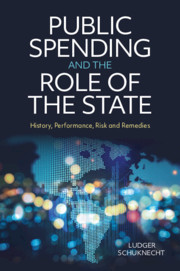Book contents
- Public Spending and the Role of the State
- Public Spending and the Role of the State
- Copyright page
- Dedication
- Contents
- Figures
- Tables
- Preface
- Acknowledgements
- Acronyms and Abbreviations
- Introduction
- Part I The Growth of Government
- 1 The Growth of Government Expenditure over the Past 150 Years
- 2 The Composition of Expenditure
- 3 Financing Government
- Part II Value for Money
- Part III Fiscal Risks
- Part IV Remedies
- Table of Data Sources
- Bibliography
- Index
3 - Financing Government
from Part I - The Growth of Government
Published online by Cambridge University Press: 30 October 2020
- Public Spending and the Role of the State
- Public Spending and the Role of the State
- Copyright page
- Dedication
- Contents
- Figures
- Tables
- Preface
- Acknowledgements
- Acronyms and Abbreviations
- Introduction
- Part I The Growth of Government
- 1 The Growth of Government Expenditure over the Past 150 Years
- 2 The Composition of Expenditure
- 3 Financing Government
- Part II Value for Money
- Part III Fiscal Risks
- Part IV Remedies
- Table of Data Sources
- Bibliography
- Index
Summary
Government expenditure needs to be financed. The two ways to do so are via taxes or via deficits and debt. For the first 90 of the past 150 years, public expenditure broadly grew in line with revenue, except during wars and times of crises. This changed fundamentally in the 1960s and early 1970s as the ‘Keynesian revolution’ took hold.Over the past fifty years, revenue rose strongly, but public spending often increased even faster. Chronic deficits stoked a high and growing stock of public debt in much of the advanced world. Public debt in the largest countries is now similar to the level prevailing at the end of the Second World War. Future governments will also face significant liabilities from increasing public expenditure related to population ageing, as well as fiscal risks from the financial sector. These liabilities and risks imply higher expenditure which will need to be financed. At the same time, there are political and economic limits to both taxation and indebtedness.
Keywords
- Type
- Chapter
- Information
- Public Spending and the Role of the StateHistory, Performance, Risk and Remedies, pp. 60 - 78Publisher: Cambridge University PressPrint publication year: 2020



